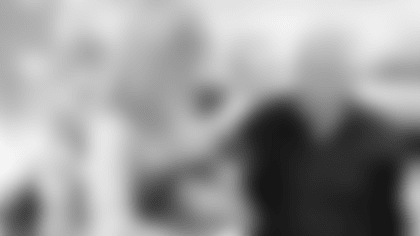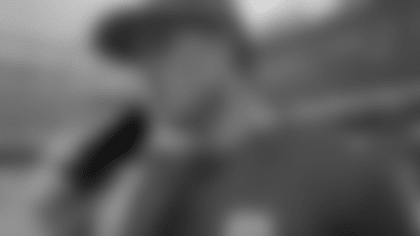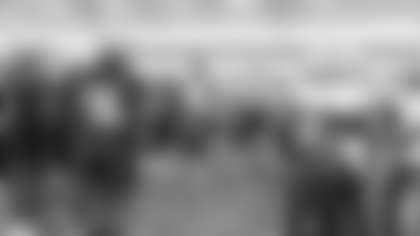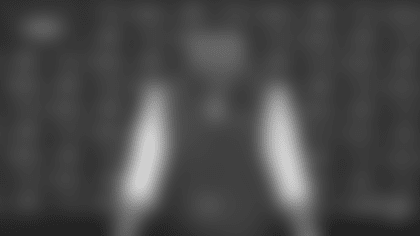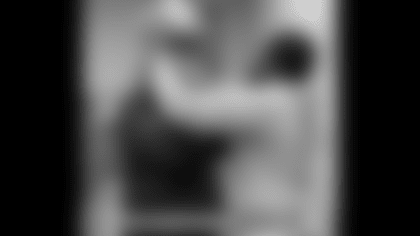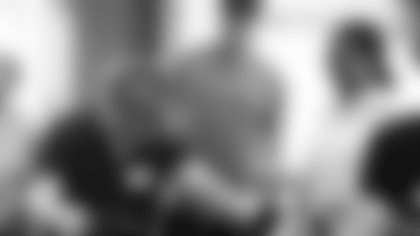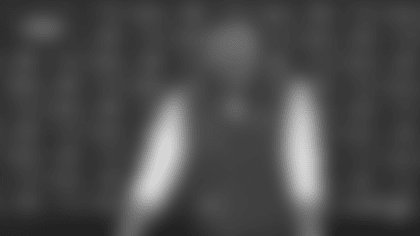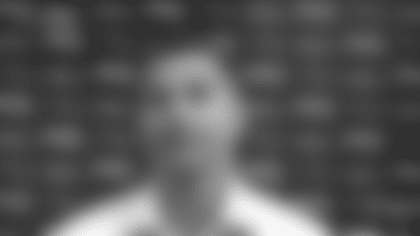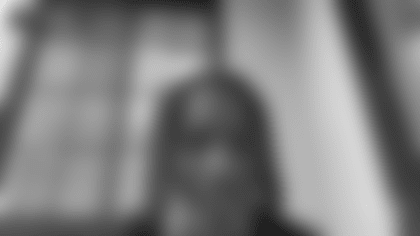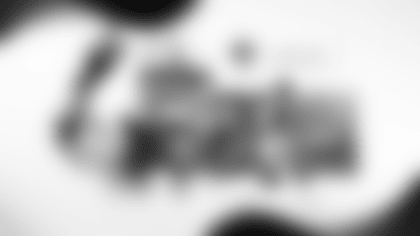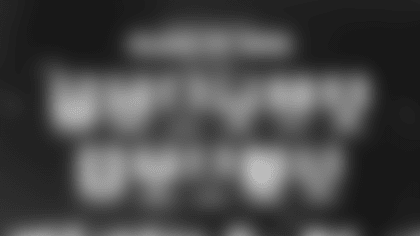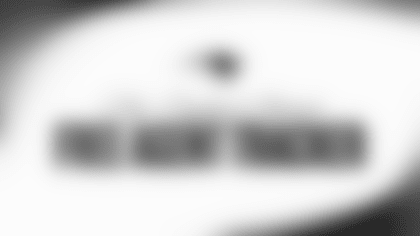BB: Alright, how's it going today – ready for another week? It is hot, that's what we need. Well, we'll get in a good day today and try to get a little bit of a jump on New Orleans tomorrow so we can go down there and be prepared to practice against them this week. It's a good week for our football team on a lot of different levels. Hopefully we can do a good job of taking advantage of it and getting the most out of it, so I'm looking forward to it.
Q: What did you see from Trey Flower's first sack during the preseason game against the Packers? It seemed like his leverage was excellent.
BB: Yeah, I'd agree with that. He generally plays with good leverage. He has longer arms, and he uses his hands well, and he did that on that play; showed some acceleration to the quarterback.
Q: A player at his size, six-foot-two with long arms, is that a different combination that what you usually see at that position?
BB: Yeah.
Q: Is there anybody that stands out to you from the past [that Trey Flowers reminds you of]? I was thinking Elvis Dumervil.
BB: Yeah, I've never really coached [Dumervil]. I think he's like six-feet, but same kind of thing.
Q: Overall, what has Trey shown you since arriving here after being drafted, in terms of picking things up?
BB: Good. I think he's an instinctive player. We've asked him to do a lot of things, and he's played a number of different positions. He's played in the kicking game, which wasn't something that he did a lot of at Arkansas, but he's a tough kid, works really hard, and he seems to have a nose and instinct for the ball.
Q: We don't have any injury reports for a while, but if we put something together on Trey, are we going to be OK? We're not going to lose him to injured reserve or anything like that?
BB: You've got the inside track on that stuff. You probably know more than I do.
Q: When a guy moves from the outside to the inside, what are the adjustments they need to make? I know you're supposed to play with good leverage all the time, but is playing with good leverage the most important adjustment you have to make when moving inside?
BB: Yeah, I think you put it well. You always want to play with good leverage, no matter where you are, but the players out at the end of the line – the tackles and the defensive ends are generally longer and maybe have a little tendency to play higher. A lot of times you have players that are a little bit shorter in there in the interior positions, although there are some six-foot-four guards, too, so I wouldn't characterize them all that way. But generally speaking, [there's] a little less length inside than outside. I think the biggest difference, though, is just how fast everything happens inside and how quickly they have to react, whichever side of the ball they're on. I don't know what the percentage is, but it's got to be pretty high – 85 percent, 90 percent of the time, the offensive tackle blocks the defensive end, in a four-man line anyway. If you did that on every play offensively, you'd probably get most of them right. Inside, it's a little bit different. Centers and guards block combinations of linebackers and defensive linemen, depending on how the plays unfold and if there is movement inside, which usually there is a little more movement inside than there is outside. For a defensive tackle, you have the potential down-block, double team blocks from both sides – both the tackle and guard, center and guard, or if you're on the nose, from either guard with the center. So, it's a lot of more of a question of where they're coming from, whereas for a defensive end, the number of times he gets down-blocked by a tight end, it happens, but the frequency is a lot lower. How quickly those guys are on you and how they can come from different spots, it's a much higher variety and it happens pretty quickly. I'd say that's the big adjustment in there.
Q: I know Geneo Grissom played a lot of different spots in college, but how do you think he's adjusted here? It seems like he's played some outside and some inside.
BB: Yeah, same thing. Trey played inside against a couple teams – I want to say LSU was one – but Geneo played in there more. They had a couple pretty good defensive ends at Oklahoma, and so he was kind of the guy that moved inside with [Eric] Striker and the other kid that will probably be out this year. So, he moved a little inside, but he's played out on the edge a decent amount, too. He played four-technique his junior year, in 2013. Last year, [he played] a little more out on the edge, outside linebacker. So, he's had more experience doing that. I think that's maybe come a little more naturally to him. He also has gotten a lot of reps in the kicking game, which has been good. He's an athletic player, but it's something that he hadn't done a lot of. I would say his overall experience in the inside positions is more than say Trey's was, although Trey had some, too. We've been working them both in there, so they're both getting in [reps].
Q: You mentioned his athleticism special teams-wise, but what is it that makes him good?
BB: He's 200 and whatever he is – 265, 270 pounds. He runs well. He's athletic. He can change directions in space, and he covers ground. He can run down the field on punts, kickoffs, get back. Or even on the kick returns, being able to either match up with his man or get back and get set up on the kick return game, playing the wedge, adjusting in space. So, for a big guy, he moves well. He's got good athleticism.
Q: What have you thought about Jerod Mayo's training camp, coming back from an injury? Do the younger players look up to him?
BB: I think everybody looks up to Jerod. Jerod was a captain from his second year on, like Devin [McCourty]. It's a little bit unusual I think to see players be a captain in their second year. I think that takes kind of a special person to earn that much respect in a short amount of time. Jerod did that, Devin did that – it's not really that long of a list. But I think everybody looks up to him – not just the younger players, although they certainly do. Jerod has made progress day by day from last year in the offseason, even during the season when he was working every day in his rehab to the offseason, to this spring, to this training camp. Nobody works harder than Jerod does, and I think he's making progress day by day. We'll just see where that gets to, but he's coming along. We've asked him to do a little bit more, either the amount of work that he does or maybe we've increased the intensity up a little bit. In the two-and-a-half weeks that we've been in training camp, I think he's handled those well, and so we'll just keep going here and see how it goes.
Q: When you talk about conditioning, what exactly are you looking for in terms of conditioning from a player?
BB: It depends on the position, but the guys who do a lot of running do a lot of running. The guys who do a lot of – like boxers – leaning and pushing other heavy bodies with a lot of force and trying to move heavy people in short distances and move quickly in short spaces. It's a different kind of conditioning. But they're all important. Each player has position-specific type of conditioning, that's why when we condition the players, we do some overall general conditioning that everybody does, but we also do a lot of our conditioning where we break it up into specific groups, so a receiver's conditioning is different from an offensive lineman's conditioning and so forth. Or a special teams player's conditioning, who may go in for one play and then be out for a few, and then go in for one play, so it's just different.
Q: How much do you talk to Jim Whalen and the medical staff during a week like this, or is it just standard operating procedure?
BB: Yeah, we talk every day. We always try to get the most out of every opportunity we have to practice. Again, those are limited, so we try to get the most out of them. Each player's physical conditioning – his physical condition and conditioning are unique to that player. Even players at a certain position, there may be different levels of conditioning within that position. Some guys need extra, some guys frankly don't need as much from whatever the norm is, whatever the standard is, so we try to take that on a case-by-case basis. And again, we modify it for some specific positions and specific people, but at the same time try to build team chemistry and the teamwork part of it. At some point everybody has to do everything together. So, there's a balance there.
Q: What have you seen from Jonathan Freeny and James Morris in camp so far?
BB: Jonathan wasn't with us last year. He came in in the spring, had a real good offseason, good spring in terms of his physical conditioning and development and also learning our defense and the communication and so forth. James, even though he didn't obviously practice last year, he was here for a lot of meetings. He's a smart kid, and he has a very good understanding of our defense. So, he might have been a little bit, even going into his second year, I would say that part of his game was pretty good. He really needed the physical development and the actual playing and so forth. So, he's gotten a lot of reps and he's taken a lot of snaps. I think both players are progressing well. I think both of them can help us defensively and in the kicking game and have some versatility. So, I think it's a good competition, good depth at that position.
Q: When you go away for joint practices, do you plan on bringing everyone, or is it smarter to leave behind guys who are trying to rehabilitate?
BB: Again, really it's an individual conversation. We talk about each player that would fall in that category, what would be the best thing for him, and then we have to utilize our resources. But it could go either way. Some guys we'll take depending on their injury and situation; other guys we won't. It's really on a case-by-case basis. If we feel like we can get productive work with them and so forth, then that's a reason to take him. But I don't think anybody would recommend a lot of travel for somebody rehabbing from injury. I don't think that's like the top of the 'Here's how you get better quick – travel, jump on a couple planes, fly around the country'. So, that's generally not part of the prescribed rehabilitation. But if there is good reason for the person to travel for them to get whatever work it is or do whatever it is wherever we are, then that's something we would talk about.
Q: What are your thoughts on the new players you've added over the last week – Ryan Groy and Casey Walker?
BB: Casey, we lost him off our practice squad last year to Baltimore, and then that's kind of recycled. We liked working with him last year, and now we have another opportunity to do that, so we'll see how that goes. Ryan gives us some depth in the interior part of the line, a little bit of experience. He's played in there – I think he started three or four games last year, so we'll put him in competition with the other players that we have there. In the end, we kind of felt like he would give us a little more competition and was better able to compete at his position than the player we traded.
Q: Will you have any time for fun on this trip? I was wondering if you'll try to get on the Old White Course at The Greenbrier.
BB: No, I don't think there will be any golf clubs on this trip. It's a business trip. There are a lot of things that we can do to help our football team. We have a lot of work to do when we're down there, both with the Saints and then also watching the practices. Now that the preseason games are starting to roll in, looking at our early opponents as well as the teams that will be upcoming on our preseason schedule – the Panthers and the Giants. Really now is the time of year when a lot of times you're looking at three, four, five different teams – New Orleans, getting ahead on Carolina, the Giants, Pittsburgh, obviously – teams in the early part of the schedule just to kind of start to get a feel for them of what you did in the offseason, is that kind of what we're seeing now in training camp or preseason games from them. Are they doing something different? What new players do they have? How are they utilizing them? Where are they showing up in the depth chart? We don't know that when we do the spring scouting reports for sure back in May for example or June. At least now there is some tape, there is some evidence of, 'This is where the guy's playing, this is who he's playing behind', or with or whatever it is. So, honestly, we have quite a bit to do. It's a big trip for us – both for our team, but we also have to try to keep staying ahead of the things that will be coming up pretty quickly. Yeah, I don't think this will be a big golf weekend, nor does it need to be.


